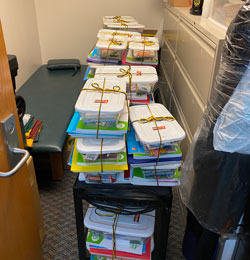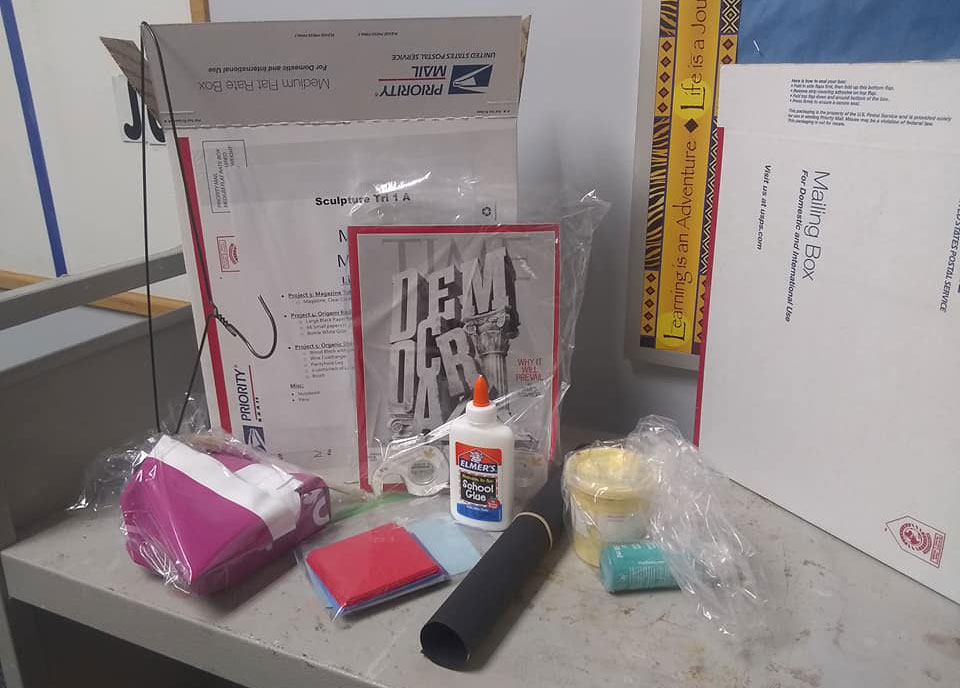When considering a student’s needs for virtual learning, you may think of computers or tablets, a decent internet connection and a cleared-off spot at the kitchen table.
But a teacher will tell you that only scratches the surface. When school buildings closed in the spring due to the coronavirus pandemic, students lost access to items like markers, scissors, notebooks and other typical classroom supplies. And that doesn’t even take into account the special items needed for classes like science or art.
“A lot of times in the spring, whatever the assignment was, I would get pencil or pen drawings on lined paper, because that’s what (students) had at home,” said Rosanne Steffens, Godfrey-Lee elementary art and high-school sculpture teacher. “We used junk mail and glue to make bird houses because, again, that’s what they had at home.”

This fall, Godfrey-Lee teachers had the opportunity to learn from last spring’s challenges. With the entire district starting school remotely for a few weeks and some students staying remote for the semester or year, teachers put together and distributed supply kits for their students — whatever they might need for a class — to help make sure everyone can be successful at home.
Sticky Notes + Magazines + Coat Hangers = Learning
For Maggie Cherry, a remote teacher for the third grade this year, the process involved several hours of shopping and then a large assembly line on her dining room table. The kits for her third-graders include most items students would usually have access to at school: pencils, a pencil sharpener, crayons, sticky notes, a dry-erase board with markers and an eraser, notebooks, math and phonics workbooks, a ruler and more.
Some funding for the supplies came out of Cherry’s classroom budget, while the rest was donated by School Supply Santa, a local nonprofit.
Cherry said her students — more than 40 of them — were very excited to learn that they’d be receiving supply boxes, and parents have been appreciative. She said she hopes the kits will help her students to be able to work at their own pace.
“I think the challenge for me is developing resources that align with our curriculum, with which students will be able to interact digitally or virtually,” Cherry said. “Also, since the class numbers in virtual (classes) are a bit higher than the in-person numbers — in order to make face-to-face teaching more manageable with social distancing — I think the volume of assignments to check will be a challenge.”

In Steffens’ case, even though many of her high-school sculpture students will return to classrooms after four weeks of remote learning, she still needed to figure out how to help them sculpt during the weeks spent learning online. Her solution was to give each student a supply kit for every project she had scheduled during that time.
The kit for the week on linear sculptures, for example, contained old magazines, rolls of double-stick tape and pieces of corrugated cardboard. Another kit, for the week they learned about British artist Henry Moore’s type of organic-shape sculpting, included a drop cloth, a section of a 2-inch-by-4-inch board with holes drilled in it, pantyhose, latex and acrylic paints, a paintbrush and a wire coat hanger. Most of the supplies were donated or reclaimed, including paint from local manufacturer X-Rite and wood from a construction site; Steffens estimates she spent a little more than $20 on the rest.
For each project, Steffens has her students submit photos of their completed sculpture from different angles – including a selfie – which she can use for grading. Breakout Zoom meetings allow students to review their peers’ work in an “online gallery walk,” and each student also submits a video reflection to discuss the decisions they made while sculpting. Steffens said these videos help her get to know the students better during the remote period.

Extra Mile is Worth It
“It has been a challenge,” said Steffens of trying to stay one step ahead of teaching both remote sculpting and in-person elementary art classes.
“I’m treading water as fast as I can; I work late every night. But you figure out new tricks every day.”
Cherry said the whiteboards and dry-erase markers from the kits she put together have already been a hit with her third-graders, since they use them for responding during Zoom class. During independent reading time, she’s also noticed her students reading donated books that came with their kits. And even though preparing these supplies for remote learners took some extra time this fall, Cherry thinks any educator would agree that it’s worth it.
“I know that what I am doing is no different from what my co-workers have done and are doing to help enhance distance learning and ensure success for all of our students,” she said.










